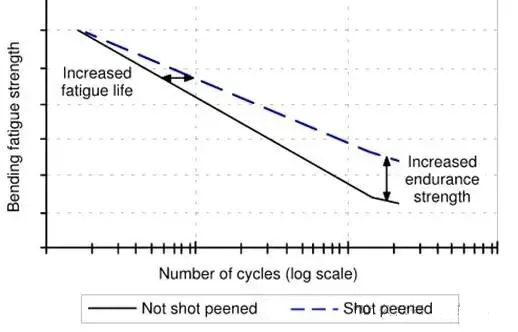Shot peening is a cold working process where a stream of high-speed shots bombards the metal surface, introducing residual compressive stress into the surface layer. This process significantly enhances the fatigue strength of gears, making them “tough inside and strong outside.”
1. Concept and Principle of Shot Peening
Shot peening is achieved by bombarding a metal surface with small spherical media at high velocity. Each shot impact creates a tiny dimple, forcing the underlying material to plastically deform. The surrounding material resists this deformation, leading to the formation of a stable compressive stress layer.
Think of it as a “gentle high-frequency hammering” on the surface.
- Difference from ordinary shot blasting:
- Purpose: Shot blasting focuses on cleaning (removing rust, oxide scale), while shot peening focuses on strengthening.
- Control: Shot peening strictly controls parameters such as shot velocity, flow rate, coverage, and intensity, making it a precision process.
- Strengthening effect of residual compressive stress: Fatigue cracks usually initiate at the surface where tensile stress is maximum. In gears, the tooth root bears the highest alternating stress. Shot peening introduces residual compressive stress up to 800–1000 MPa within 0.1–0.3 mm depth, effectively offsetting applied tensile stress.
A simple formula illustrates this:
σ_total = σ_applied + σ_residual
- When applied tensile stress (σ_applied) is combined with residual compressive stress (σ_residual), the total stress σ_total is significantly reduced—sometimes even turning tensile stress into compressive stress. This makes it difficult for cracks to initiate and propagate, thus boosting bending fatigue strength.
- Microstructural strengthening: Shot peening increases dislocation density by over 1000 times, refines grains to the micron level, and transforms retained austenite into martensite. This results in work hardening, improving hardness by 0.5–2 HRC and enhancing wear resistance.
2. Key Process Parameters
Shot peening is not simply “spraying shots”—its effectiveness depends on precisely controlled parameters:
1) Shot Peening Intensity
- Measured using Almen test strips (commonly type A, hardness HRC 44–50).
- Intensity is expressed as arc height (mmA or inchA). Example: 0.40 mmA = arc height of 0.40 mm.
- Typical gear shot peening intensity: 0.35–0.60 mmA.
2) Coverage
- Percentage of surface covered by dimples.
- Minimum requirement: 100% coverage, often specified as 200%+ for full strengthening.
3) Shot Media
- Material: Cast steel shots (HRC 45–62), cut wire shots (rounder, more consistent), glass beads (light, smooth surface finish), ceramic beads (high hardness, long life).
- Shape: Spherical for uniform compressive stress.
- Size: 0.1–1.0 mm. Selected based on gear module and root fillet radius (generally ≤ half of root radius).
4) Process Flow
- Pre-cleaning → Shot peening → Post-cleaning → Inspection (Almen strip test, coverage check).
3. Benefits of Shot Peening for Gears
- Bending fatigue strength improvement: For carburized and quenched gears, bending fatigue limit can increase by 30% or even 50–100%.
- Pitting resistance: Work hardening and compressive stress delay micro-pitting initiation and propagation.
- Stress corrosion resistance: Compressive stress layer helps block crack initiation in corrosive environments.
In summary, shot peening is not just a surface treatment—it is a precision strengthening technology that directly improves gear reliability, durability, and performance under heavy loads.
Thank you for reading. We are looking forward to serving you with our exceptional gear solutions. #BeyondGears
Read More:


